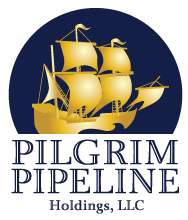Pilgrim Pipeline Submits Use and Occupancy Permit Application in New York

Pilgrim Pipeline Holdings announced it has filed a use and occupancy permit application in New York to construct the Pilgrim Pipeline. The proposed 178-mile pipeline project consists of two separate, parallel underground lines running between supply and distribution terminals in Albany and Linden, New Jersey.
The pipeline would carry refined products like gasoline, diesel, kerosene and home heating oil to the north and crude oil southbound. It would handle an estimated 200,000 bpd each direction (a total of 73 MMbbls annually), roughly the amount of fuels currently transported along the Hudson by other modes of transportation.
“This step begins a comprehensive process of review and public comment in New York. Applications for permits will be filed in New Jersey later this year.”
In February, Pilgrim President Errol Boyle told P&GJ the company estimates the pipeline would replace more than 1,200 barge trips per year. Based on EPA and state data, the annual total greenhouse gas emissions in carbon dioxide equivalent (CO2e) for transporting the crude and refined products by the Pilgrim Pipeline would be about 20% lower than moving the same volumes of crude and refined products by barge.
As designed, the $820 million Pilgrim Pipeline would consist of a products pipeline running north from the harbor to Albany, delivering barrels that are currently arriving by barge, Boyle said. A separate pipeline will deliver crude oil to the harbor without the need for unit trains.
The pipelines would cover 58 miles in New Jersey and 115 in New York along the same route. Preliminary plans call for the pipelines to be no more than 24 inches in diameter. The system would ship crude from Albany to the liquids hub in Linden, NJ and have shut-off valves at 10-mile intervals.
The application was filed with the New York State Thruway. It includes a three-volume draft environmental impact statement (DEIS) in compliance with both the New York State Environmental Quality Review Act (SEQRA) and the National Environmental Protection Act (NEPA).
“The Pilgrim Pipeline was sited to minimize environmental impacts to the greatest extent practicable while taking into account pipeline design, construction means and methods, delivery points, and the continued economic viability and growth of the region,” the application said. “To this end, of the ±116 miles of the mainline in New York State, Pilgrim proposes to locate the vast majority (about 79%) within the New York State Thruway right-of-way.”
Related News
Related News

- Keystone Oil Pipeline Resumes Operations After Temporary Shutdown
- Biden Administration Buys Oil for Emergency Reserve Above Target Price
- Freeport LNG Plant Runs Near Zero Consumption for Fifth Day
- Enbridge to Invest $500 Million in Pipeline Assets, Including Expansion of 850-Mile Gray Oak Pipeline
- Williams Delays Louisiana Pipeline Project Amid Dispute with Competitor Energy Transfer
- Evacuation Technologies to Reduce Methane Releases During Pigging
- Editor’s Notebook: Nord Stream’s $20 Billion Question
- Enbridge Receives Approval to Begin Service on Louisiana Venice Gas Pipeline Project
- Russian LNG Unfazed By U.S. Sanctions
- Biden Administration Buys Oil for Emergency Reserve Above Target Price




Comments